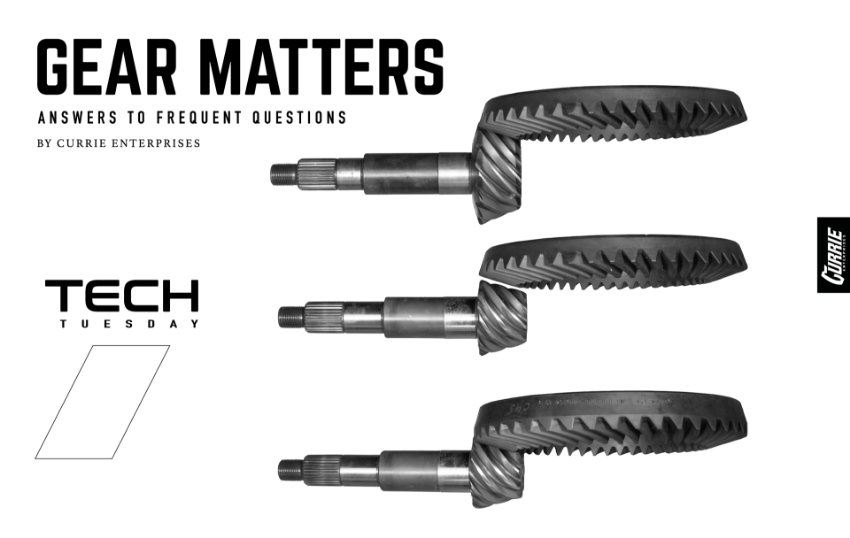At Currie Enterprises, we discuss the details of ring and pinion gears with our customers every day. While many of the conversations are difficult to summarize, many are of a straightforward, technical nature that can be addressed with a more concise question and answer format. Below (in no particular order) are some of the most frequent topics.
Q: What is a carrier break?
A: Axle assemblies are designed to accept a wide range of gear ratios, and most will have two different carrier or differential offsets (see image) to accommodate a “break” between numerically low and high gear ratios. The term carrier break describes the point at which a different carrier is required. The carrier break offset compensates for the difference in pinion gear diameters between low and high ratio gears (see image). A Dana 60 has a carrier break between 4.10/4.56 ratios, meaning that ratios numerically lower than 4.10 will use one carrier, while numerically higher gears will use another. The point at which the carrier break takes place varies by axle manufacturer and model. Ford corporate axles like the 8.8, 9, 9.75, 10.25 and 10.5-inch, do not use carrier breaks, but instead, rely on varying ring gear thicknesses to compensate for the change in pinion head diameter.


Q: What are thick and thin gears?
A: The term "thin gear" is a bit of a misnomer, in that the gears are not thin, but are rather standard OEM production gears. Thick gears, on the other hand, are predominately aftermarket gears that are manufactured with additional material to increase the overall thickness. The additional thickness is an exact match for the offset of the carrier break and allows a numerically high thick gear to be installed on a low carrier. A typical example is an F-250 truck with a D60 front and factory 3.73 gears, switching to a 4.88 ratio would generally require a carrier change (see carrier breaks above). However, using a thick gear allows the stock low carrier to be retained.

Q: Are thick gears stronger than thin gears?
A: We wish there were some engineering data to answer this question definitively, but unfortunately, we don't think it exists. Our standard practice is to use thick gears in all of our off-road axles. If the extra material makes them stronger, that’s great; if not, then there’s no harm done. With regard to the on-road performance side, it's a bit of a moot point, because the 9-inch rearend does not have a carrier break, so for this application, there's no such thing as thick or thin gears.
Q: What's the difference between 8620 and 9310 gears?
A: The standard answer is, 8620 is used for street/strip gears where a hard long-wearing gear is desirable, and 9310 is used for high-impact racing applications where a softer (but tougher) gear is needed. However, that's not the full story, as advancements in custom heat-treating have made it possible to create 9310 gears that are capable of excelling at both roles. The 8620 material is a low-nickel steel alloy that produces a very hard and somewhat brittle gear. 9310 is a superior alloy that contains additional chromium and nickel, enabling it to be more malleable or flexible, and able to withstand higher shock loads without fracturing.
Heat-treating is the secret sauce that, in large part, determines the properties of a finished gear. Modern gears go through a computer-controlled heat-treating process that is tuned to achieve the desired outcome. Both 8620/9310 can be heat-treated to similar surface hardness, but 8620 cannot be made as malleable or tuff as 9310.
Historically, 9310 gears were used for drag racing, and the heat-treat process was engineered to maximize the alloy's malleable property to the detriment of hardness. This is the reason most people believe that 9310 gears are soft and only suitable for drag racing. However, with proper heat-treatment 9310, alloy gears can be nearly as hard as an 8620 gear, while retaining most of the malleability that makes them tuff. As an example, the ring and pinion gears used in our Currie 70 high-pinion axle, are manufactured from custom heat-treated 9310 alloy and have proven their on-road durability and off-road toughness over many years of harsh use.

